Before you dump that extra pound of grain into your horse’s feed bucket, think about what you are giving him. Does he really need it? Sure, you rode for an extra hour today, but does that warrant the added calories? Possibly not.
Once a horse has finished growing, his work level will dictate his feeding program. When feed matches need, the horse has sufficient nutrients for maintenance and to perform his work without becoming either too fat or too thin. The horse owner’s first step in deciding how to feed his or her horse is to properly define the horse’s work level so the animal is neither underfed nor overfed.
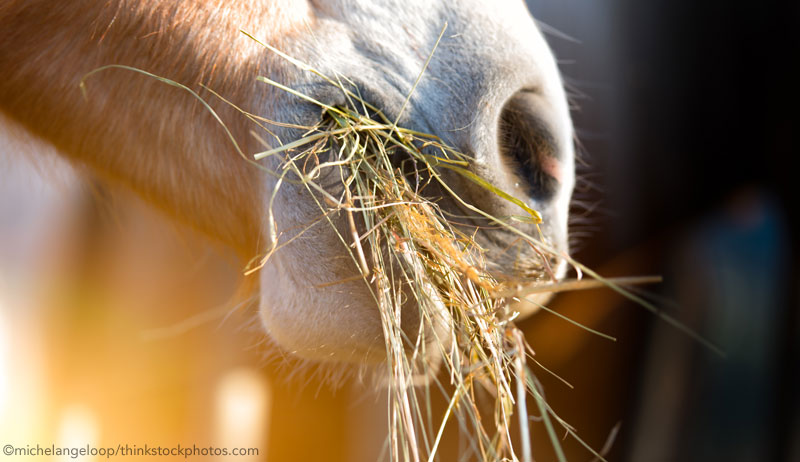
The Idle Horse
A horse that is worked less than three hours a week is considered an “idle” horse. An idle horse needs between 1.5 and 2 percent of his body weight daily in feed, with about 10 percent overall protein in the diet. High-quality pasture of hay can provide 100 percent of this basic maintenance diet. When forage quality is less than ideal, 2 to 3 pounds of a grain mix fortified to complement the hay or pasture conditions in your region can help keep vitamins and minerals at sufficient levels for a typical 1,200-pound horse.
For horses on primarily pasture diets, keep in mind that grasses can be 70 percent (or more) water. Therefore, horses maintained solely on pasture need sufficient grazing time to take in the amount of grass they need on a daily basis. Depending on the growing stage of the grass, the grazing horse must harvest about 3 to 4 pounds of grass to get the same number of calories as he could get from eating a pound of hay. Weather, soil conditions, the types of grasses or legumes planted and many other factors can affect grazing.
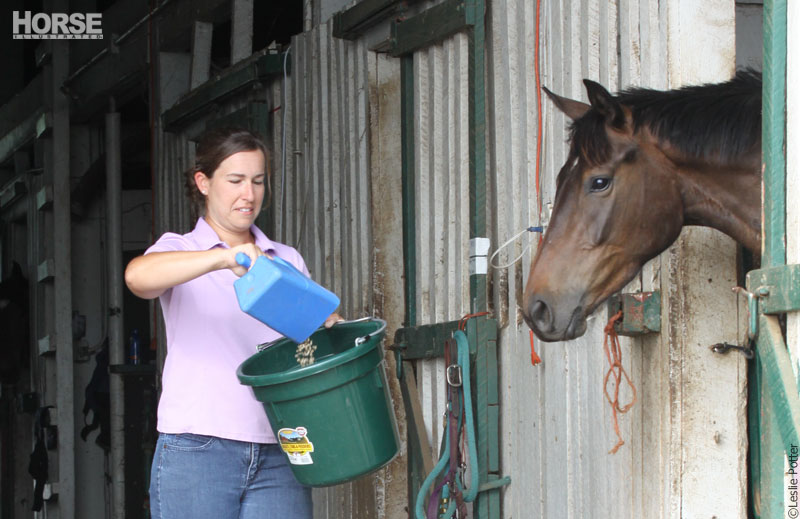
Pleasure Horses
Many pleasure horses are overfed because their owners think they are working very hard. However, nutritionists would actually classify their workload as light. Even the horse that earns a living as an equitation horse or as a western-pleasure mount that is ridden one or two hours a day, five or six days a week is doing “light” work. These horses aren’t breaking a sweat the same way a cutting, reining or barrel horse does. The work level of one of these western performance horses would be considered “moderate,” and the amount of calories they need in their diet should increase accordingly. Most horses doing jumping or dressage at higher levels would also fall into the “moderate” work category.
When equine nutritionists refer to grains and commercial grain mixes as “concentrates” they mean they are sources of concentrated energy or calories for the horse. Concentrates are generally lower in fiber and higher in starch than forages. Some grain mixes contain added fat to boost their calorie content, which lowers the amount of starch (grains) that the horse must eat to meet his needs. The horse takes in more calories per mouthful of concentrates than he does when eating pasture grass or hay.
Nature’s plan for the equine digestive tract did not include concentrated feeds. Horses didn’t need concentrated forms of energy in their diets until man put them to work and limited the hours they could graze on pasture or hay. Feeding grains became necessary so that working horses could consume sufficient calories in the time they had available to eat. Whether or not a modern horse needs concentrates depends on his workload.
The horse doing light to moderate work needs about 1.5 to 2.5 percent of his body weight daily in feed, with about 10 percent of that from protein. Like the idle horse, good-quality forage should still be the cornerstone of the diet. Depending on the workload, the typical 1,200-pound horse doing light to moderate work may need from 3 to 10 pounds of a 10- to 12-percent crude-protein grain mix fortified with vitamins and minerals that complement the type of forage fed.
A horse may move back and forth between “light” work and “moderate” work as competitive seasons and training schedules change. Make gradual adjustments in the horse’s calorie levels to match the animal’s workload as it changes.
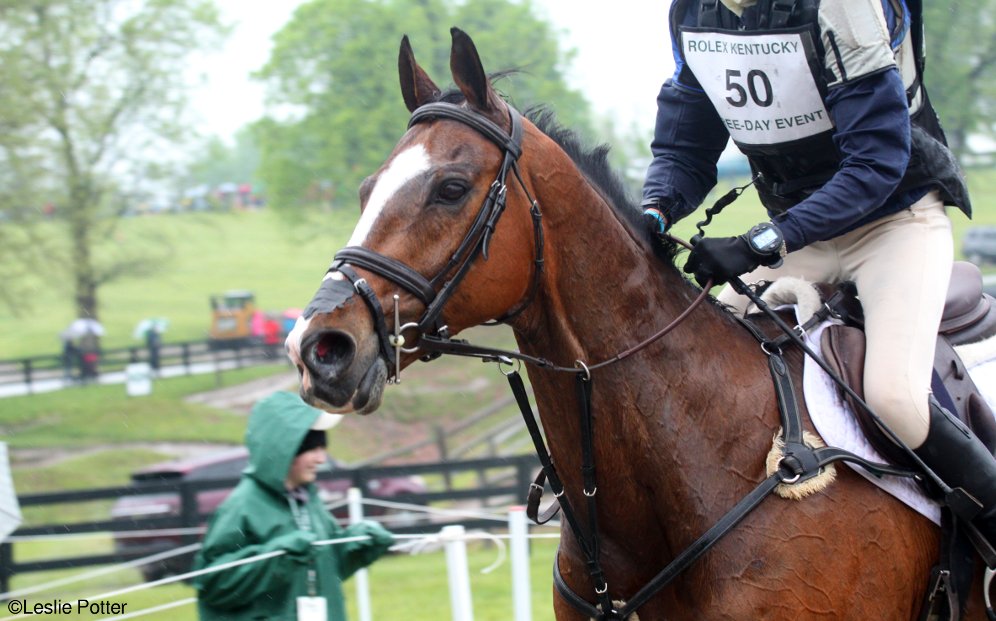
Intense Work
Horses in sports that call for intense levels of training and fitness, such as racing, upper-level eventing, polo or endurance racing, have high calorie needs. These horses need from 2 to 3 percent of their body weight daily in feed, with a 10- to 12-percent protein level in the total diet. In order to consume sufficient calories, horses engaging in intense work may need as much as 50 percent of their daily feed intake, by weight, in concentrates.
Making sure that a horse consumes sufficient feed daily at this work level sometimes becomes a challenge. The time demands of training and the schedule changes dictated by travel and competition often disrupt both normal feeding times and the horse’s appetite. Providing top-quality, highly palatable feeds is essential to making sure the horse eats enough to take care of his daily needs.
Premium commercial feed mixes aimed at this market often have added fat to make them more calorie-dense and because research has shown some positive links between fat metabolism and energy availability. When fat is increased and starched is decreased, there is a lower risk of metabolic and digestive disorders, such as colic, founder and tying-up. Horses doing intense work need a well-fortified grain mix that provides slightly higher levels of vitamins and minerals. They may also need added salt and other electrolytes during periods of physical exertion, especially in hot weather.
Balancing Needs
When the calories the horse takes in do not roughly match the calories the horse needs for maintenance plus work, the horse becomes either fat or thin. The horse that is too thin has no energy reserves or stamina, while the fat horse has unnecessary stress put on his heart, other internal organs, and his joints. An overly fat or overly thin horse can also present breeding problems.
Dr. D.R. Henneke and his colleagues at Texas A & M University developed a scoring system that has become the industry standard for evaluating a horse’s body fat. It ranks animals on a scale of 1 (extremely thin) to 9 (extremely fat) by looking at the fat deposits (or lack of them) along the back, the horse’s ribs, the neck, the shoulders, the withers and at the top of the tail.
While a hard-muscled, athletic horse might actually score on the thin side of the Henneke scale because of extreme fitness, the typical horse doing light or moderate work should score about 5 or 6. That means ribs can be felt but not easily seen, a thin layer of fat blends the neck and shoulder together smoothly, withers are smoothly rounded, there is barely a crease or no crease at all down the horse’s back, and a moderate layer of fat smoothly blends the back and hindquarters at the top of the tail.
Changing a horse’s workload without changing his feed intake is an obvious reason for weight gain or loss. Many other factors can also affect a horse’s calorie needs and intake. In cold weather, a horse may need extra calories to burn in order to stay warm. During fly season, pastured horses may seek shelter and reduce their grazing time, thereby reducing the amount of feed they are taking in. A new load of hay may not be as nutritious and calorie dense as the previous load. Parasites may be interfering with efficient digestion. Genetic programming alone can cause some horses to be hard-keepers, while others on a similar diet can be easy-keepers.
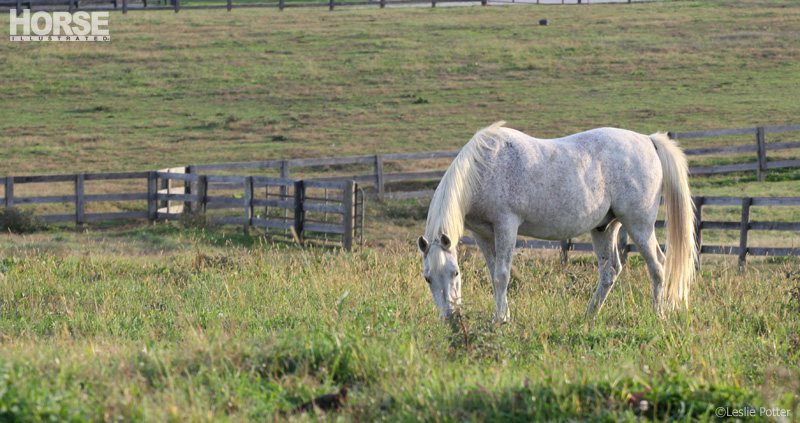
The Aged Horse
Age is one of the factors that can shift the horse’s nutritional needs. The older horse’s digestive tract may not be as efficient as it once was because of a lifetime of fighting parasites or simply from wear and tear. Absorption of vitamins, minerals and energy, and the synthesis of proteins and certain vitamins within the horse’s body simply may not be what they used to be. Hormonal changes may affect coat condition and other bodily functions.
Older horses with dental problems may have trouble taking in enough calories to maintain good condition, since worn teeth make it harder to chew grains and even stemmy hay. Sometimes just taking extra care to select fine-stemmed, leafy hay is enough to help these veterans. Chopped hay, forage pellets or cubes, or alternative forages, such as beet pulp, often benefit the older horse that can no longer efficiently process long-stem hay. Cracked, crimped or steamed and flaked grain may also aid digestion and absorption.
Gradually introducing from ½-cup up to 2 cups of vegetable oil daily into the older horse’s feed is a good way to add extra calories without increasing the volume of feed the horse must eat. Pay close attention to vitamin and mineral levels in the horse’s overall diet, especially vitamins A, D, C, and the B vitamins, such as niacin and riboflavin, since the horse’s ability to store and synthesize these vitamins may be compromised by age.
Many manufacturers have developed feeds formulated especially for senior horses. These products combine forage and concentrates into a pelleted or extruded complete feed that can be easily chewed by teeth that have lost their grinding surfaces over the years. Added fats boost the calorie content and higher levels of vitamins and minerals help horses with an inefficient digestive tract achieve more balanced nutrition.
Monitoring Change
It is a good idea to learn how to use a weight tape, then measure your horse every other week, or at least monthly. By doing this, you note subtle changes in your horse’s condition before they require major changes in your feeding program.
To maintain a consistent feeding program, feed your horse by weight, not by volume, of feed, and know the protein and nutrient content of the feeds. Volume measurements such as scoops and flakes are an imprecise way to feed a horse. A scoop of plump, top-grade oats can weigh 25 percent more than a poor grade of thin oats with a higher ratio of fibrous hulls to starchy kernels. A scoop of corn may have twice the calories of a scoop of oats. Most feed stores stock inexpensive hanging scales for measuring feeds or a flake of hay. Once you know what a particular volume of your horse’s feed weighs, you can go back to eyeballing volume if that simplifies feed time. If you get in a new load of hay or switch to a different grain mix, however, get the scale out again, check weights and evaluate the difference in quality between the old and new feedstuffs.



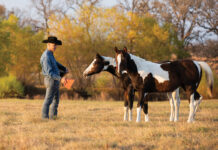

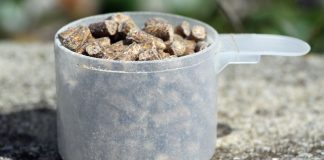

Thank you for saying what the “big” feed companies don’t want the horse owner to know. Most horses do not need pounds of feeds (or any at all) a day!!!
This was very helpful. I would love to hear more about the feeding regimines for specific classes and yearling horses.
Thanks for all the good advice…
Good advice